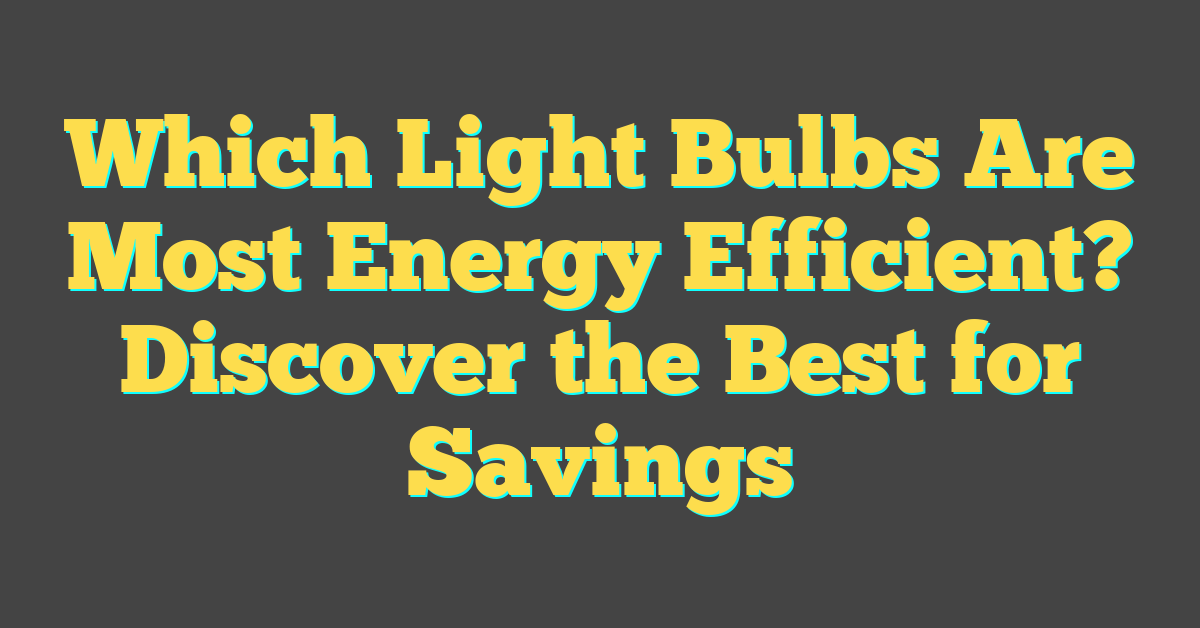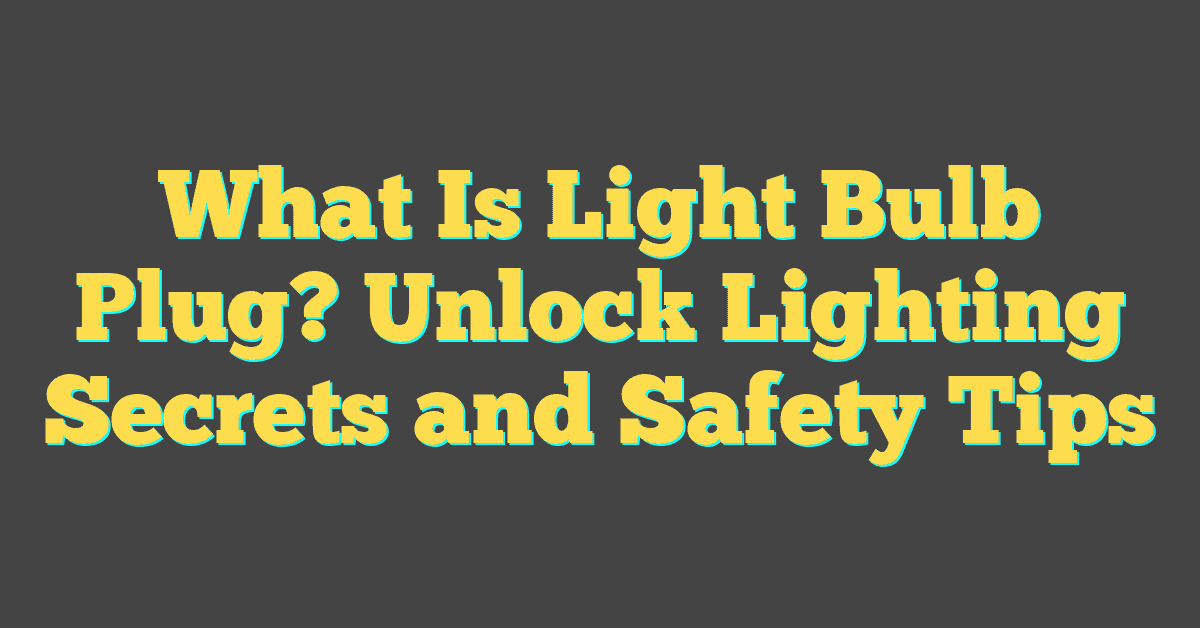Ever wondered why your energy bill’s running high? It might be time to look up from your smartphone and consider those little glowing orbs above you. Yep, we’re talking light bulbs, and trust us, not all are created equal when it comes to energy efficiency.

You’re smart about a lot of things, but when’s the last time you gave a thought to the type of bulbs lighting up your home? With a dizzying array of options, it’s hard to know which ones will save you money and reduce your carbon footprint.
Types of Light Bulbs
When you’re standing in the lighting aisle, looking for the best energy-efficient bulbs, you’ll find three main types: LEDs, CFLs, and Halogens. Each has its own benefits and drawbacks, but they don’t shine equally when it comes to energy efficiency.
LED Bulbs: Leaders in Efficiency
LEDs, or Light Emitting Diodes, are the marvels of modern lighting. Not only do they boast a remarkable lifespan, often lasting up to 25 times longer than traditional incandescent bulbs, but their energy consumption is impressively low. Did you know LEDs use about 75% less energy? Plus, they don’t emit heat the same way other bulbs do, which means less strain on your cooling system during those hot summer months.
LEDs come in a range of colors and brightness, and they reach full brightness immediately when switched on. They’re perfect for your home DIY lighting projects, adding both flair and functionality with minimal energy draw.
CFL Bulbs: The Cost-Effective Choice
Compact Fluorescent Lamps or CFLs are those spiral-shaped bulbs you’ve likely seen around. They use about 70% less energy than incandescent bulbs and can last up to 10 times longer. Initially, they take a bit of time to warm up to their full brightness, which makes them less ideal for certain applications.
CFLs have dramatically dropped in price as their popularity has increased. They’re a cost-effective option for your home, especially in fixtures that you leave on for extended periods.
Halogen Bulbs: When Brightness Counts
Halogens are essentially a more efficient version of the old-school incandescent bulb, using a filament encased in halogen gas to produce light. While they’re more efficient than their predecessors, they’re not at the top of the energy-saving list, using about 20% to 30% less energy than traditional incandescents.
| Bulb Type | Energy Savings over Incandescent | Average Lifespan |
|---|---|---|
| LED | 75% | Up to 25 times longer |
| CFL | 70% | Up to 10 times longer |
| Halogen | 20-30% | Slightly longer than incandescent |
Incandescent Bulbs

When you’re delving into the wide world of light bulbs, you can’t skip over incandescent bulbs— they’re the classic choice that’s been illuminating homes for more than a century. Incandescent bulbs work by heating a filament inside the bulb until it glows, producing light. While their warm, inviting glow might remind you of a cozy, well-lit room, it’s important to note that these bulbs are not champions of efficiency.
If you’re taking on a home DIY project or just trying to improve your home lighting, you should know that incandescent bulbs convert less than 10% of their energy into visible light. That’s right—over 90% of the energy they consume is lost as heat. This inefficiency is a huge drain compared to other lighting options on the market.
Despite their lackluster performance in energy conservation, incandescent bulbs do offer some benefits:
- Instant On: They don’t require any warm-up time.
- Color Rendering: Colors under incandescent light often appear more vibrant and true to life.
- Dimmable: They work well with dimmer switches, allowing for adjustable ambiance.
That being said, when it comes to energy usage, incandescent bulbs can’t hold a candle to LEDs or CFLs. To put it into perspective, let’s look at a comparative analysis:
| Type | Energy Used | Lifespan |
|---|---|---|
| LED | Low | Up to 25x |
| CFL | Medium | Up to 10x |
| Incandescent | High | Base Value |
Upgrading to LED or CFL bulbs might require an initial investment, but you’ll see the payback in energy savings before long. Plus, with fewer bulb replacements, you’re not only saving money but also saving yourself from the hassle of frequent trips to the store—which, if you’re anything like me, means more time to tackle other projects on your DIY list.
CFL Bulbs

« Are All Light Bulbs The Same Size? Discover the Key to Perfect Lighting
Can You Change a Light Bulb With the Power On? Shocking Truth Revealed »
Compact Fluorescent Lamps, commonly known as CFL bulbs, are your go-to if you’re aiming for energy efficiency on a budget. They’re the curly versions of long tube fluorescent lights you’ve seen in kitchens and garages. Here’s why they might just be what you’re looking for in your next home project.
CFLs use about 70% less energy than incandescent bulbs, striking a satisfying balance between upfront cost and long-term savings. The twist here is that they also last about 10 times longer than their incandescent counterparts. You won’t find yourself climbing up the ladder to replace them as often.
- Here’s a quick rundown of what you get with CFLs:
- Good energy savings
- Less heat emission compared to incandescent
- A variety of color temperatures, so whether you’re going for a warm or cool look, you’re covered
But remember, CFLs do contain a small amount of mercury—about 4 milligrams on average. Though it’s not much, proper disposal is key to prevent any harm to the environment.
Another point to consider is that CFLs take a short time to warm up to their full brightness. This may not be ideal for all scenarios, especially if you need instant light as soon as you flip the switch. However, once they’re on, you’ll enjoy consistent light without the immense energy drain of incandescent bulbs.
Pairing CFLs with compatible dimmers can also be tricky. Ensure you’ve got dimmable versions and the right hardware to avoid flickering or reduced bulb life. Your well-planned home lighting project deserves the right combination of efficiency and functionality, and CFLs can be a cost-effective element in that mix.
As you move from room to room, assessing which bulb fits best, keep in mind your lighting goals. Are you looking for longevity or the lowest upfront cost? The choice might just light itself up.
LED Bulbs

While you’re exploring energy-efficient lighting, LED bulbs shine as the pinnacle of modern illumination technology. Known for their remarkable energy efficiency and longevity, LED (Light Emitting Diode) bulbs stand out in the world of eco-friendly options. These bulbs use a fraction of the energy consumed by incandescent and CFL bulbs with impressive lifespan measurements that redefine the market’s standards.
LEDs offer an array of benefits:
- Substantial Energy Savings: LEDs use about 75% less energy than traditional incandescent bulbs.
- Long Life: Expect an LED to last up to 25 times longer than an incandescent bulb.
- Durability: They’re more resistant to breakage since they’re made with a small chip encased in an epoxy resin, rather than a fragile glass bulb and filament.
Here’s a quick look at the stats comparing LED to traditional bulbs:
| Bulb Type | Energy Usage | Lifespan |
|---|---|---|
| LED | Low | Very Long |
| Incandescent | High | Short |
| CFL | Moderate | Long |
If you’re a fan of customizable lighting, LEDs are absolutely your ally. They come in a wide color range, from warm, inviting tones to crisp, cool hues that mimic daylight. Their dimming capabilities are stellar, eliminating the compatibility concerns often associated with CFLs. You can create the perfect ambiance for any room without sacrificing energy efficiency or control.
Moreover, unlike CFLs, LEDs provide instant light without any warm-up time. This makes them an excellent choice for all types of applications—from your evening reading lamp to the motion sensor lights in your garage. You don’t have to wait; the light is there the moment you need it.
As for environmental impact, LEDs are a safer choice as they contain no mercury, reducing potential hazards associated with bulb disposal. The advances in LED technology also mean a continuous drop in prices. While they might have a higher upfront cost compared to other bulbs, you’ll notice the savings in your energy bills. Additionally, the market is teeming with LED options tailored for practically any light fixture or design project you’ve got on your DIY list.
Comparing Energy Efficiency

When you’re considering which light bulbs to use for your next home DIY project, energy efficiency is likely a key factor. Different bulbs not only have varied lifespans but their energy consumption can also make a huge impact on your electricity bill and environmental footprint. Let’s break down the energy usage of the most common light bulbs:
Incandescent Bulbs: The old-school choice for many households, incandescent bulbs are energy hogs. A significant portion of the energy they consume is lost as heat rather than light.
Compact Fluorescent Lights (CFLs): A leap forward from incandescent bulbs, CFLs use about 70% less energy. However, their lifespan is shorter than LEDs and they take a bit of time to reach full brightness.
Light Emitting Diodes (LEDs): At the forefront of energy conservation, LED bulbs are the champions. To put their efficiency into context, check out the following table comparing the average wattage used by each type of bulb to produce approximately the same amount of light:
| Bulb Type | Average Wattage |
|---|---|
| Incandescent | 60W |
| CFL | 14W |
| LED | 10W |
As the chart demonstrates, LEDs consume the least amount of energy. Additionally, LEDs shine bright the moment you flick the switch, with no pesky warm-up time.
Beyond the basic numbers, consider the longevity and durability of LEDs. They’re a brilliant pick for hard-to-reach places due to their extended life span—imagine changing a bulb once every few decades instead of every few months. Also, for outdoor lighting projects, LEDs are remarkably resilient against temperature fluctuations and inclement weather.
As LEDs continue to evolve, so do their capabilities for customization. You can create accent lighting with a spectrum of colors, adjust brightness to set the mood, or even sync your lights to music or smart home systems—all while trimming down your energy use. Remember, while the upfront cost might pinch, the long-term savings on your energy bill and bulb replacement are well worth the investment.
Conclusion
So you’ve got the scoop on energy-efficient lighting! LED bulbs are your go-to for slashing energy use and keeping those bills in check. They outshine the rest with their long life and robust performance. Remember, while the initial price tag might be a bit higher, you’ll be pocketing the savings for years to come. It’s a bright idea to switch to LED and light up your space with efficiency and style. Happy lighting!
Frequently Asked Questions
What are the main benefits of LED bulbs?
LED bulbs are energy efficient, using about 75% less energy than incandescent bulbs, and they can last up to 25 times longer. They’re durable, offer instant lighting without a warm-up period, and do not contain mercury.
How long can LED bulbs last?
LED bulbs can last up to 25 times longer than traditional incandescent bulbs. This can translate to a lifespan of several years, depending on usage.
Are LED bulbs more energy-efficient than CFL bulbs?
Yes, LED bulbs are more energy-efficient than CFL bulbs. They consume less energy and also provide instant light without any warm-up time.
Can LED bulbs be used in any type of fixture?
LED bulbs can be used in most fixtures and are particularly suitable for hard-to-reach areas and outdoor settings due to their durability.
Do LED bulbs have customizable lighting options?
Yes, LED bulbs offer a wide range of customizable lighting options, including different color temperatures and dimming capabilities.
Is it cost-effective to replace incandescent bulbs with LED bulbs?
Despite a higher upfront cost, the long-term savings incurred from reduced energy bills and less frequent bulb replacements make LED bulbs a cost-effective choice over time.
Are there any environmental benefits to using LED bulbs?
LEDs are an environmentally friendly option because they use less energy, have a longer lifespan which means less waste, and they don’t contain mercury, making them safer to dispose of compared to CFL bulbs.




